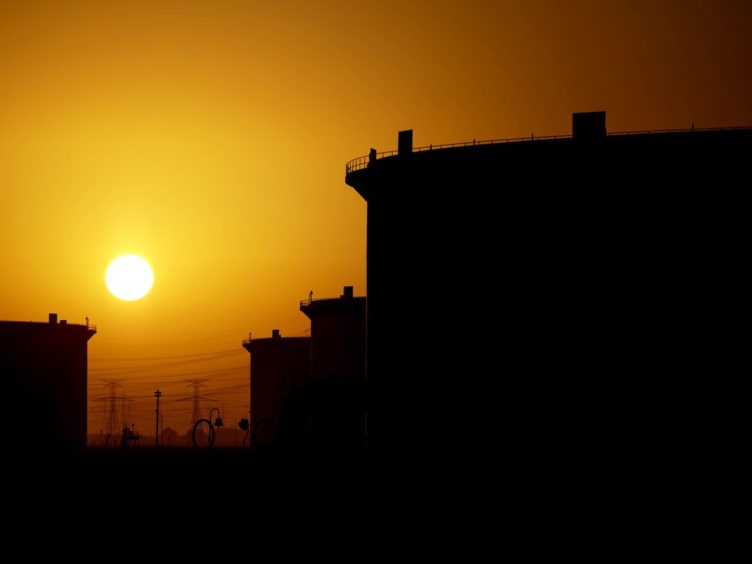
The OPEC+ alliance descended into bitter infighting after a key member blocked a deal at the last minute, forcing the group to postpone its meeting and casting doubt on an agreement that could ease a surge in oil prices.
The standoff between the United Arab Emirates and the rest of the cartel could ultimately mean that OPEC+ won’t increase production at all, according to a delegate. Without a deal it would fall back on existing terms that call for output to remain unchanged until April 2022. That would squeeze an already tight market, risking an inflationary price spike.
The dramatic turn of events leaves the market in limbo — just as inflationary pressures are fixating investors with oil above $75. It also tarnishes the cartel’s carefully reconstructed reputation, raising the spectre of the destructive Saudi-Russia price war of last year.
Earlier on Thursday, the Organization of Petroleum Exporting Countries and its allies appeared to have an agreement in principle to boost output by 400,000 barrels a day each month from August to December. It would also have extended the duration of the broader OPEC+ accord, setting the final expiry of the cuts in December 2022 instead of April.
That preliminary agreement was upended by the United Arab Emirates, which said it will block the deal until the baseline for its own cuts is adjusted, effectively raising its production quota, delegates said.
“Any request to adjust the production quota would be like opening Pandora’s box,” said Giovanni Staunovo, a commodity analyst at UBS Group AG. That could add up to a production increase of about 700,000 barrels a day for the UAE alone, and “other OPEC+ states might also request an adjustment.”
Global crude benchmarks held gains on Friday after jumping Thursday as members of the cartel ended the day with no resolution. The September contract for Brent oil rose by the most in almost two weeks, while West Texas Intermediate closed above $75 a barrel for the first time since 2018.
Angry Rejection
The UAE’s cuts are measured from a starting point in 2018, setting its maximum capacity at about 3.2 million barrels a day. Expansion projects have since raised that number and the country wants its baseline reset to about 3.8 million barrels a day, delegates said.
The UAE argues that the change is necessary because, under the current terms of the OPEC+ deal, it is making proportionally deeper cuts than other members. That unfairness would persist for even longer if the accord is extended until the end of 2022.
Yet, reflecting the emirates’ new capacity in its baseline could allow the country to pump hundreds of thousands of barrels a day of extra crude while technically remaining in compliance with its obligation to cut.
Russia and Saudi Arabia, the leaders of the group, angrily rejected the UAE’s request, delegates said. Talks will resume on Friday, allowing time for consultations at higher levels of government, delegates said.
“It’s hard to see either side backing down enough to get a clean outcome tomorrow,” said Richard Bronze, head of geopolitics at consultant Energy Aspects Ltd. “Talks may even extend through the weekend, as any compromise will likely involve complicated OPEC maths.”
For the UAE, the baseline is a very significant issue and it will reject the OPEC+ deal until there’s a change, a delegate said after the meeting was adjourned. The Saudis are equally insistent that the extension of agreement until December 2022 is vital for market stability next year, delegates said.
Oil has risen around 50% this year, with the recovery in demand from the pandemic outpacing the revival of OPEC+ supplies after last year’s deep cuts. Crude’s surge, combined with a rally in other commodities, has central banks fretting about inflation again.
OPEC+ is already in the process of reviving crude supplies halted last year in the initial stages of the pandemic. The 23-nation coalition decided to add about 2 million barrels a day to the market from May to July, and the question before ministers on Thursday was whether to keep going in the coming months.
The market has experienced a supply deficit for much of this year as the group’s output increases didn’t keep pace with the demand recovery. In the cartel’s view, that’s been an entirely necessary remedy — the only way to deplete the vast surplus in fuel stockpiles that accumulated as economies went into lockdown.
Now, the group’s data show oil inventories are back down to average levels as a strong revival in fuel consumption continues. Demand in the second half will be 5 million barrels a day higher than in the first six months of the year, OPEC Secretary-General Mohammad Barkindo said on Tuesday.
Yet there are several factors that could undo the rally. If the US reaches a nuclear deal with Iran, the end of sanctions could result in an influx of new supply. The highly infectious delta variant of Covid-19, which is already sending some countries back into partial lockdown and triggering a worrying rise in cases in other nations, threatens the demand recovery.
With these risks in mind, Saudi Energy Minister Prince Abdulaziz bin Salman has repeatedly urged OPEC+ to revive its idle capacity cautiously and gradually.
The oil market witnessed another Saudi-UAE clash play out at an OPEC+ meeting in December last year, which also resulted in an adjourned meeting and delayed talks. Riyadh had wanted a simple extension of the group’s cuts, but Abu Dhabi ultimately pressed them to allow a modest output increase.
“Another OPEC+ implosion like last April is unlikely,” said Vandana Hari, founder of oil consultancy Vanda Insights. “They have worked too hard over the past year to ditch the pact in a huff at this stage. I expect the tentative deal between Saudi Arabia and Russia to go through, but some sort of concession may be made to the UAE.”